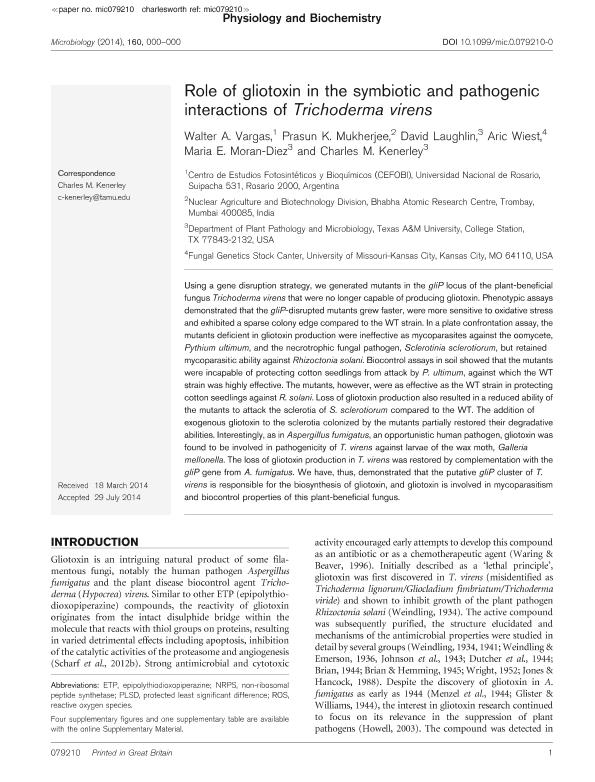Artículo
Role of gliotoxin in the symbiotic and pathogenic interactions of Trichoderma virens
Vargas, Walter Alberto ; Mukherjee, Prasun K.; Laughlin, David; Wiest, Aric; Moran Diez, Maria E.; Kenerley, Charles M.
; Mukherjee, Prasun K.; Laughlin, David; Wiest, Aric; Moran Diez, Maria E.; Kenerley, Charles M.
 ; Mukherjee, Prasun K.; Laughlin, David; Wiest, Aric; Moran Diez, Maria E.; Kenerley, Charles M.
; Mukherjee, Prasun K.; Laughlin, David; Wiest, Aric; Moran Diez, Maria E.; Kenerley, Charles M.
Fecha de publicación:
10/2014
Editorial:
Maik Nauka/interperiodica/springer
Revista:
Microbiology
ISSN:
0026-2617
Idioma:
Inglés
Tipo de recurso:
Artículo publicado
Clasificación temática:
Resumen
Using a gene disruption strategy, we generated mutants in the gliP locus of the plant-beneficial fungus Trichoderma virens that were no longer capable of producing gliotoxin. Phenotypic assays demonstrated that the gliP-disrupted mutants grew faster, were more sensitive to oxidative stress and exhibited a sparse colony edge compared with the WT strain. In a plate confrontation assay, the mutants deficient in gliotoxin production were ineffective as mycoparasites against the oomycete, Pythium ultimum, and the necrotrophic fungal pathogen, Sclerotinia sclerotiorum, but retained mycoparasitic ability against Rhizoctonia solani. Biocontrol assays in soil showed that the mutants were incapable of protecting cotton seedlings from attack by P. ultimum, against which the WT strain was highly effective. The mutants, however, were as effective as the WT strain in protecting cotton seedlings against R. solani. Loss of gliotoxin production also resulted in a reduced ability of the mutants to attack the sclerotia of S. sclerotiorum compared with the WT. The addition of exogenous gliotoxin to the sclerotia colonized by the mutants partially restored their degradative abilities. Interestingly, as in Aspergillus fumigatus, an opportunistic human pathogen, gliotoxin was found to be involved in pathogenicity of T. virens against larvae of the wax moth, Galleria mellonella. The loss of gliotoxin production in T. virens was restored by complementation with the gliP gene from A. fumigatus. We have, thus, demonstrated that the putative gliP cluster of T. virens is responsible for the biosynthesis of gliotoxin, and gliotoxin is involved in mycoparasitism and biocontrol properties of this plant-beneficial fungus
Palabras clave:
Trichoderma Virens
,
Gliotoxina
,
Control Biológico
,
Proteccion Vegetal
Archivos asociados
Licencia
Identificadores
Colecciones
Articulos(CEFOBI)
Articulos de CENTRO DE EST.FOTOSINTETICOS Y BIOQUIMICOS (I)
Articulos de CENTRO DE EST.FOTOSINTETICOS Y BIOQUIMICOS (I)
Citación
Vargas, Walter Alberto; Mukherjee, Prasun K.; Laughlin, David; Wiest, Aric; Moran Diez, Maria E.; et al.; Role of gliotoxin in the symbiotic and pathogenic interactions of Trichoderma virens; Maik Nauka/interperiodica/springer; Microbiology; 160; 10-2014; 2319-2330
Compartir
Altmétricas



